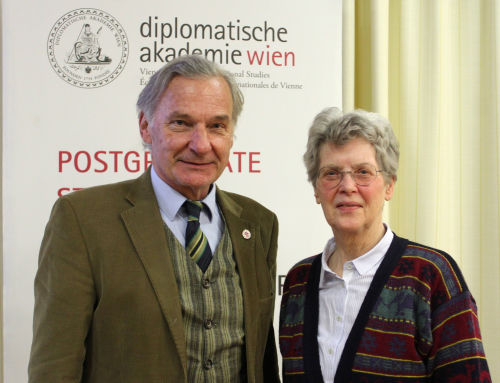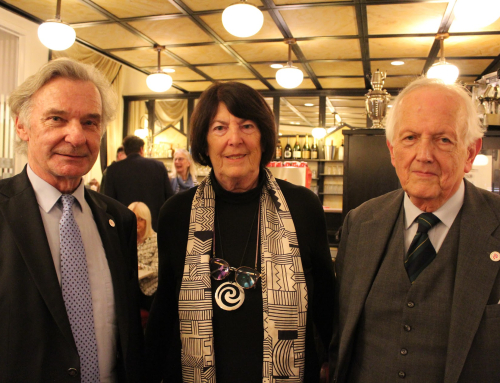Review of the private screening of the film “Emily” at the Votiv Kino on Thursday, January 19, 2023.
By Wolfgang Geissler
Upon my arrival at the Midland Hotel in Bradford in 1971, where British Transport Hotels sent me for one year before being expected back to the Midland Hotel in Manchester, I happened to pick up their hotel brochure. I was amused with the description of Yorkshire then. It said Yorkshire seems to be pushing Lancashire into the sea. A snide remark of the White Rose of Yorkshire against the Red Rose of Lancashire, I mused.
Yorkshire was divided into three Ridings. It was because the ridings were abolished in 1974 during the last reorganisation of local government, but local affection for the term and the boundaries has never really waned.
The Three Ridings of Yorkshire are the ancient division of the county and the creation of the Norse period from which Yorkshire itself arose. Yorkshire, the largest county in the United Kingdom with over 5 million inhabitants, is most conveniently divided. The three ridings are the shire’s fundamental geographical and cultural divisions.
The three ridings surround the City of York, their boundaries meeting at the city’s walls: thus, “York within the Walls” is the only part of Yorkshire outside any of the ridings. Each riding is divided into Wapentakes, the Danelaw equivalent of the Anglo-Saxon “Hundred” in most other counties. A “Hundred” had enough land to sustain approximately a hundred households.
The name “Riding” is from the Old Norse “Thriding”, meaning a “thirding”. The term “Thriding” survived into the Middle Ages.
Now, Bradford, just west of Leeds, lies in the West Riding, and some further 14 kilometres to the West is the so-called Brontë Country with Top Withens, the inspiration of “Wuthering Heights” on the moors above Haworth. I was taken to this spot back then, with the strange landscape of bleak rolling hills with wuthering (wild) winds gusting into my face, which left me with a lasting impression.
The Pennine village where the Brontë sisters grew up was then a crowded industrial town, polluted, smelly and wretchedly unhygienic. Although perched on the edge of open country, high up on the edge of Haworth Moor, the death rate was as high as anything in London or Bradford, with 41 per cent of children failing even to reach their sixth birthday. The average age of death was just 24.
Villagers typically subsistence farmed a few acres, often ‘take-in’ from the moors, which they combined with hand-loom weaving or wool-combing. But worsted weaving on a loom in your front room was already on its way out by the time the Brontë family arrived in the village in 1821; new water-powered mills began appearing along the River Worth from 1790, and the economy began shifting from domestic to industrial.
People tended to devote time to religious worship when they had some to spare. Baptist and Wesleyan chapels flourished in the village and, together with the Anglican Church, provided the village with education and social life.
Emily Brontë was one of six children born to Reverend Patrick Brontë and Maria Branwell Brontë. Born in Thornton, Yorkshire, on July 30, 1818, she was the sister of Maria, Elizabeth, Charlotte, Anne, and Branwell. Her family moved to Haworth when she was two years old, and here she first experienced the moors, a part of the Pennine Chain of mountains, here she lived until she died 30 years later.
A variety of conflicting influences shaped her life. Her father, of Irish descent, was known for his poetry and imagination even though he was a cleric. Her mother, a staunch Methodist, died when Emily was only three years old, so what she knew of her she learned from her siblings and her Aunt Elizabeth (Maria’s sister), who raised the children after Maria’s death. Elizabeth brought a religious fervour to the house that Emily Brontë soon rejected.
The village of Haworth was isolated and surrounded by moors; thus, the one world she knew and lived in became the setting for her only novel. Paralleling her own life, she creates motherless characters in “Wuthering Heights”.
Writing was a means of amusement for the Brontë children. After the two oldest sisters died, the remaining siblings began writing plays and poems, creating a world called Angria and Gondal. These worlds became little books and sources for later poetry and prose. Emily Brontë went to school, but she was unable to stay there. Possessing a reclusive nature, she had longings and desires for her home on the moors, which prompted her return home after a scant three months.
In the following year, 1837, she attempted to teach school. This endeavour lasted eight months, but she could not handle the stress and again returned home. In 1842 she went with Charlotte to Brussels to study foreign languages and school management to open a school in Haworth. Brontë had success there. One of her professors stated that she “had a head for logic and a capability for argument, unusual in a man, and rare indeed in a woman,” but she returned to Haworth when her aunt died in 1843. Although the earliest dated poem is from 1836, most of her surviving poetry was written during this time. Living with her father at the parsonage in Haworth, this became a period of creativity.
Like most authors, Emily Brontë was a product of her environment, which directly influenced her writing. She had no close friends during her life, was interested in mysticism, and enjoyed her solitude outdoors. All of these elements grace both her poems and “Wuthering Heights”. Many contemporary critics praise Emily Brontë first and foremost as a poet, marvelling at the poetic nature of “Wuthering Heights”.
In 1845 Charlotte found some of the poetry that Emily had been writing and eventually persuaded her sister to attempt to publish her work. Charlotte and Emily, along with their sister Anne, finally published a collection of poems under the male names of Currer, Ellis, and Acton Bell. Each pseudonym begins with the same consonant as the writer’s name. The sisters paid to have the collection published, and even though it only sold two copies, they were undaunted and continued to write. This time each sister wrote a novel.
Evidence suggests that Emily Brontë began writing “Wuthering Heights” in December 1845 and completed it the following year. A year after that, in July of 1847, “Wuthering Heights” was accepted for publication; however, it was not printed until December, following the success of “Jane Eyre”.
The autumn following the publication, Emily Brontë left home to attend her brother’s funeral. She caught a severe cold that spread to her lungs and died of tuberculosis on December 19, 1848.
Long after its initial publication and the subsequent death of its author, “Wuthering Heights” has become one of the classics of English literature. After the reissue of Emily Brontë’s text, the editors of the “Examiner” commented upon Charlotte’s introduction. Admirers of “Wuthering Heights” often echo their words and sentiments: “We have only most unfeignedly to deplore the blight which fell prematurely on sure rich intellectual promise, and to regret that natures so rare and noble should so early have passed away.”
Despite taking some poetic licence, the producers of “Emily”, the movie, portrayed the life and death of Emily Brontë in a very sensitive way. The insight into life in a remote village of the early 19th century, the harsh paternalistic rule and unbending morality, and the subservient role of women in those days must have been a revelation to many of our viewers.
Thus an excellent event organised by the Austro-British Society, where even our President, Prof Dr Kurt Tiroch, had to restrict himself to a very brief welcome, came to an end. What followed was what the Americans call a Vin d’Honneur, a drinks reception in the Buffet area of the cinema and bonhomie.
***






